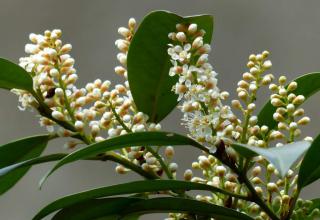

Common laurel is an evergreen shrub that is often shaped to form hedges.
Name – Prunus laurocerasus
Family – Rosaceae
Type – shrub, bay
Height – 3 to 16 feet (1 to 5 m)
Exposure – full sun to shade
Soil – ordinary
Flowering – April
Foliage – evergreen
It is appreciated for its rapid growth and its view-breaking properties.
You can plant common laurel from October to March with a preference for fall to favor root development before winter.
In the hedge, place the base of each stem at least 32 inches (80 cm) to 3 feet (1 meter) apart for a hedge around 6 ½ feet (2 meters) feet tall. If you need to climb higher, space the plants a bit more.

It is a shrub that can bear pruning well, even heavy pruning.
It is a shrub that is quite resilient to most diseases, but isn’t without its own share of parasite attacks, especially aphids.
They are easy to recognize on the underside of leaves, they are small green-colored insects.
When leaves turn yellow or begin to lose their color, it usually means that some type of nutrient is lacking in the soil, and adding fertilizer might be necessary.
Finally, if orange spots appear on the common laurel, it is due to silver leaf disease. The only solution is to eliminate infected specimens, because there is no known treatment and it would spread to the entire common laurel hedge if left unchecked.
Common laurel, also called cherry laurel, contains cyanide that one should of course never ingest.
Some herbivores can even die from it, as well as animals such as dogs who might try to taste the common laurel’s leaves, branches, or fruits.
Common laurel is an excellent natural sound barrier.
If you live near a busy passing road, near a highway or simply in a noisy neighborhood, this shrub is one of the best possible natural sound barriers there are.
Due to its dense foliage made of thick, leathery leaves, noise is absorbed and reduced much more than most other types of shrubs.
In a hedge, alternate common laurel with other evergreen shrubs to increase overall visual impact: a beautiful mixed hedge.
And also:
Credits for images shared to Nature & Garden (all edits by Gaspard Lorthiois):
Laurel berries by Ulrike Leone under Pixabay license
Common laurel floral buds by Hans Braxmeier under Pixabay license
Common laurel hedge by Roger Eavis ★ under © CC BY 2.0
Are these dear resistant ?
Hi Ardis, deer notoriously taste anything when they come upon it for the first time. Younger deer will surely take a nibble when they discover the plant. However, common laurel is more bitter than most other types of shrubs. This means that unless they’re starving, they’ll quickly head on to other plants instead. So not truly “deer resistant”, but more like “deer don’t like it much”. Hope this helps!
I love your blogs and the information listed here. Thanks for sharing this awesome information about common laurel.